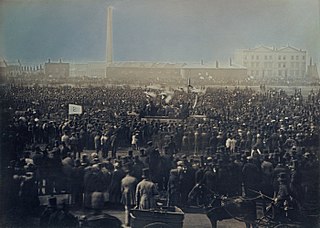
Chartism was a working-class movement for political reform in the United Kingdom that erupted from 1838 to 1857 and was strongest in 1839, 1842 and 1848. It took its name from the People's Charter of 1838 and was a national protest movement, with particular strongholds of support in Northern England, the East Midlands, the Staffordshire Potteries, the Black Country and the South Wales Valleys, where working people depended on single industries and were subject to wild swings in economic activity. Chartism was less strong in places, such as Bristol, that had more diversified economies. The movement was fiercely opposed by government authorities, who finally suppressed it.

The Great Train Robbery was the robbery of £2.61 million, from a Royal Mail train heading from Glasgow to London on the West Coast Main Line in the early hours of 8 August 1963 at Bridego Railway Bridge, Ledburn, near Mentmore in Buckinghamshire, England.
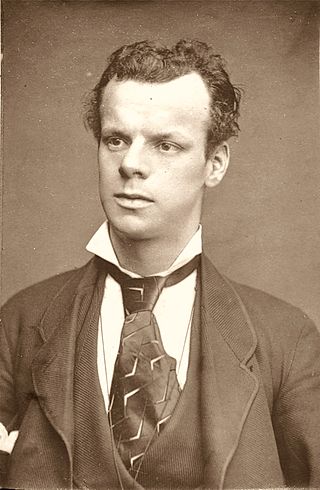
Edward O'Connor Terry was an English actor, who became one of the most influential actors and comedians of the Victorian era.

Feargus Edward O'Connor was an Irish Chartist leader and advocate of the Land Plan, which sought to provide smallholdings for the labouring classes. A highly charismatic figure, O'Connor was admired for his energy and oratory, but was criticised for alleged egotism. His newspaper Northern Star (1837–1852) was widely read among workers, becoming the voice of the Chartist movement.

Richard Edward O'Connor was an Australian politician and judge.

Sir Francis Burdett, 5th Baronet was a British politician and Member of Parliament who gained notoriety as a proponent of universal male suffrage, equal electoral districts, vote by ballot, and annual parliaments. His commitment to reform resulted in legal proceedings and brief confinement to the Tower of London. In his later years he appeared reconciled to the very limited provisions of the 1832 Reform Act. He was the godfather of Francisco Burdett O'Connor, one of the famed Libertadores of the Spanish American wars of independence.
The West End Gang is a Canadian organized crime group in Montreal, Quebec. An Irish mob group originating from the Irish-Canadian ethnic enclave of Pointe-Saint-Charles in the 1950s, the majority of the gang's earnings were initially derived from truck hijackings, home invasions, kidnapping, protection rackets, extortion, and armed robbery, with its criminal activities focused on, but not restricted to, the west side of Montreal. The West End Gang came to prominence via a series of high-profile bank robberies between the 1950s and the 1970s, a period when Montreal was known as "Bank Robbery capital of North America". Due to the gang's control of illegal activity at the Port of Montreal, it moved into drug trafficking and became one of the most influential criminal organizations in Canada.
Brian Arthur Field was an English solicitor's clerk who was one of the masterminds of the 1963 Great Train Robbery. He was the crucial link between the key informant known only as "Ulsterman" with the actual gang capable of planning and carrying out such a complex and large scale robbery. He was found guilty of conspiracy to rob, but his conviction was later overturned on appeal. Field only served prison sentence for perverting the course of justice, in relation to arranging the purchase of Leatherslade Farm, near Oakley, Buckinghamshire, which was used as the gang's hideout.
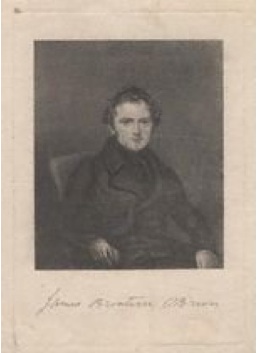
James Bronterre O'Brien was an Irish Chartist leader, reformer and journalist.

The O'Conordynasty are an Irish noble dynasty and formerly one of the most influential and distinguished royal dynasties in Ireland. The O'Conor family held the throne of the Kingdom of Connacht up until 1475. Having ruled it on and off since 967, they ruled continuously from 1102 to 1475. Moreover, the O'Conor parent house the Uí Briúin and Síol Muireadaigh ruled Connacht on many occasions – but not continuously – between 482 and 956. The house of O'Conor also produced two High Kings of Ireland, Tairrdelbach Ua Conchobair and his son Ruaidrí Ua Conchobair, the last High King of Ireland. The family seat is Clonalis House outside Castlerea in County Roscommon.
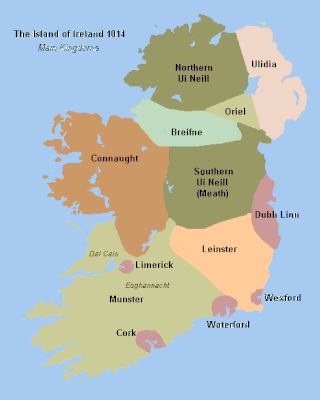
The Treaty of Windsor (1175) was a territorial agreement made during the time of the Anglo-Norman invasion of Ireland. It was signed in Windsor, Berkshire by King Henry II of England and the Ard Rí or High King of Ireland, Ruaidrí Ua Conchobair.
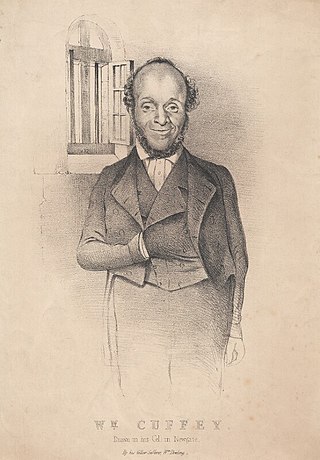
William Cuffay was a Chartist leader in early Victorian London.

The Northern Star and Leeds General Advertiser was a chartist newspaper published in Britain between 1837 and 1852, and best known for advancing the reform issues articulated by proprietor Feargus O'Connor.

The Book of Murder, also known as the Marcus Affair, was a piece of propaganda written in the 1830s in opposition to the English Poor Laws. It was presented as the work of one pseudonymous "Marcus", and was published by Joshua Hobson. It aimed to incite opposition to the Poor Law Amendment Act 1834, which had altered the nature of poor relief in England and Wales. Previously, paupers were eligible for "outdoor relief" ; this shifted to "indoor relief", meaning that workhouses were built, institutions to provide shelter and basic sustenance.
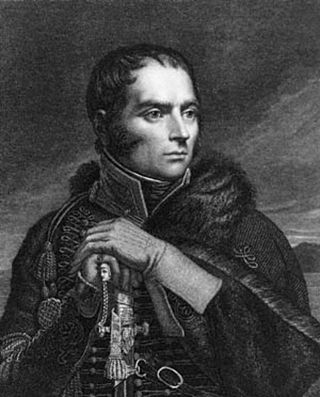
Arthur O'Connor, was a United Irishman who was active in seeking allies for the Irish cause in England and in France. A proponent of radical democratic reform, in Ireland he was distinguished by publishing political appeals to women. Arrested on the eve of the 1798 rebellion, in 1802 he went into exile in France where, after being raised to the rank of General in a force that was to invade Ireland, fell out of favour with Napoleon. Among the positions he maintained publicly in his final years were a defence of the July Revolution in Paris and opposition to what he saw as the clericalism of Daniel O'Connell's movement in Ireland.

Summerhill is a heritage village in County Meath, Ireland. It is located in the south of the county, between Trim and Kilcock on the R158 and west of Dunboyne on the R156.

Francisco Burdett O'Connor was an officer in the Irish Legion of Simón Bolívar's army in Venezuela. He later became Chief of Staff to Antonio José de Sucre and Minister of War of Bolivia. Aside from Bolívar and Sucre, he is one of the few military officers of the Spanish American wars of independence to be bestowed the title of Libertador (Liberator).
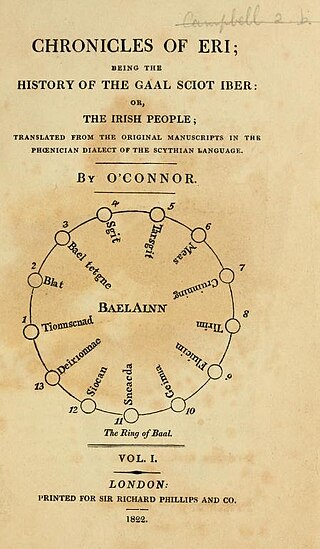
The Chronicles of Eri; Being the History of the Gaal Sciot Iber: or, the Irish People; Translated from the Original Manuscripts in the Phoenician Dialect of the Scythian Language is an 1822 book in two volumes by Roger O'Connor (1762–1834), purporting to detail the history of the Irish from the creation of the world. The work contains multiple plates and maps and is prefaced with the author naming himself "head of his race" and "chief of the prostrated people of this nation".

Dangan Castle is a former stately home in County Meath, Ireland, which is now in a state of ruin. It is situated by Dangan Church on the Trim Road. The castle is the former seat of the Wesley (Wellesley) family and is located outside the village of Summerhill. It was the childhood home of Field Marshal Arthur Wellesley, 1st Duke of Wellington.
Roderic O'Connor (1784–1860) was an Irish Australian landowner and public official, most notable for his activities as a land commissioner in Tasmania. He became one of the biggest landowners in Tasmania, and oversaw the modernisation of the land, typically using the forced labour of convicts.



















